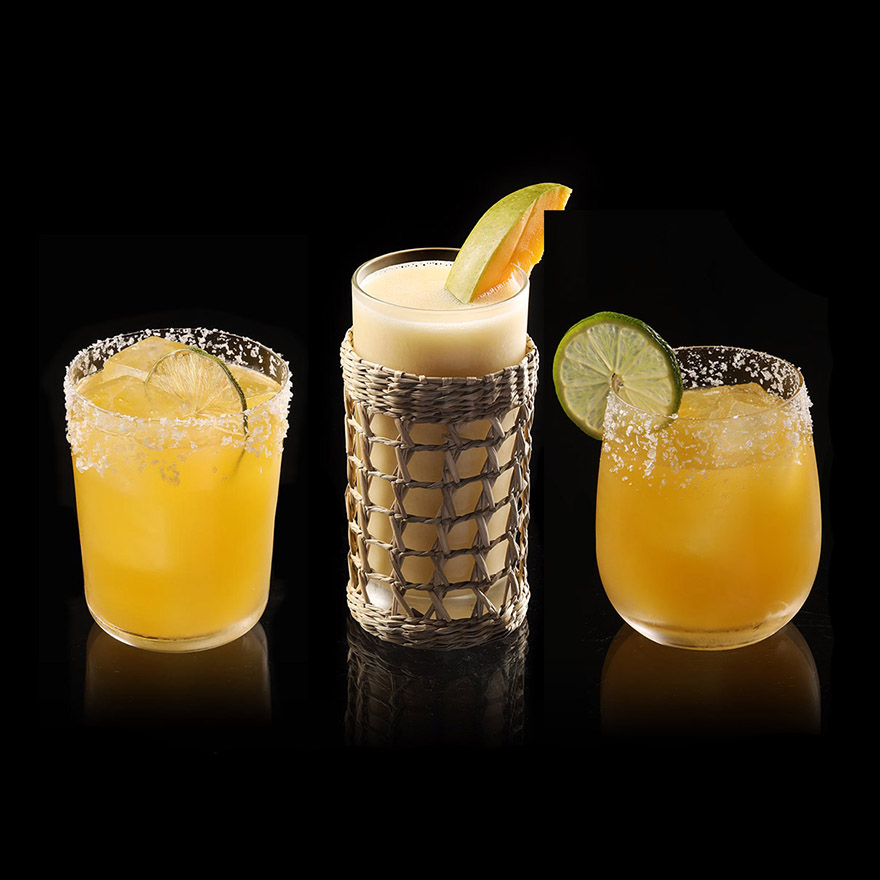Adonis

Glass:
Serve in a Coupe glass
| 1 oz | Lustau Palo Cortado Península Sherry |
| 1 oz | Lustau Amontillado Los Arcos Sherry |
| 1 oz | Strucchi Rosso Vermouth |
| 1⁄12 oz | Italian red bitter liqueur |
Prepare:
- Select and pre-chill a COUPE GLASS.
- Prepare garnish of orange zest twist and skewered green olive.
How to make:
Garnish:
- EXPRESS orange zest twist over the cocktail and discard.
- Garnish with skewered olive.
Allergens:
Recipe contains the following allergens:
- Palo cortado sherry, Amontillado sherry, Rosso/rouge/sweet vermouth (di Torino) - Sulphur Dioxide/Sulphites
Strength & taste guide:

Review:
Some describe the Adonis as "The sweet version of the Bamboo" but that hardly does this brilliant vintage aperitivo/digestivo, that's off-dry and aromatic justice.
I made the Adonis for Dan to photograph in a vintage Boadas Martini glass as the Boadas Bar's rendition of this classic is the best I've encountered. And thanks to their generosity, I have one of their last 20 original glasses and the knowledge that it's a 'secret' splash of Italian red bitter liqueur that deepens the flavour profile of their Adonis rather than the orange bitters favoured by others.
I really wanted to find a Spanish vermouth that worked best in Adonis or indeed a very expressive Torino sweet vermouth but I found these too domineering and/or overly sweet so I settled on a more standard rosso vermouth. I've also experimented with various styles of sherry and now lean towards a blend of palo cortado and amontillado.
Variant:
History:
The first known mention of the Adonis in print is in the "Pearls from Billy, the bartender" column in New York's The Sun newspaper on 27th March 1887. The column describes three customers, "three young bloods, with bell-crowned beavers of matchless sheen and silver-headed canes of ultra fashionable immensity who walk into the bar where Billy was bartending and order "Three Adonis cocktails, please." Billy proceeds the confidently make and serve them three cocktails which they drink, pay "fifteen cents each" for and leave. Then it becomes clear that Billy has no idea what an Adonis is. ""What on earth is an Adonis cocktail?" asked the reporter who had watched the incident. "Blessed if I know," said Billy, with an air of perfect frankness; "but I wouldn't be much of a bartender if I let any customer bluff me off with any new-fangled name. I gave them what I always have known as a turf club cocktail, and it suited. The first principle of good bartending is to know how to make everything on earth in the drink line, no matter whether you have ever heard of it before or not.""
This irreverent column doesn't reveal what comprised an Adonis but it does tell us that it was a "new-fangled" cocktail at the time so dating its origin prior to 1897.
It's another 16 years before the Adonis appears in a recipe book, Jacques Straub's 1913 Straub's Manual of Mixed Drinks establishing the recipe as two-thirds Italian (sweet) vermouth to one-third sherry with 2 dashes orange bitters.
ADONIS
Jacques Straub, Straub's Manual of Mixed Drinks, 1913
2 Dashes Orange Bitters.
1/3 Jigger Sherry.
2/3 Jigger Italian Vermouth.
Stir.
The origins of the Adonis name appear in Albert Stevens Crockett's 1931 Old Waldorf Bar Days where, along with the recipe, he reveals that the cocktail is named after a Broadway musical. The Adonis opened at Hooley's Opera House in Chicago in the summer of 1884 before moving to New York's Bijou Theatre in September of that year, where after 603 performances, it became the longest-running Broadway show of the era.
Crocket mentions two stars of the show, Henry E. Dixey who played Adonis and Fanny Ward who played Cupid. Both joined the show for its New York run so dating the Adonis cocktail's creation between late 1884 and 1887, most likely 1885/6.
ADONIS
Albert Stevens Crockett, Old Waldorf Bar Days, 1931
Named in honor of a theatrical offering which made at least two persons famous. One was Henry E. Dixey, a handsome and talented actor, long on Broadway; the other was Fanny Ward. Yes, Fanny Ward! One doesn't see as much of Fanny these days as one did when she played Cupid – speaking literally, that is, for Fanny in the play was Cupid. Fanny discovered England late in the last century, married a South African millionaire and had a bijou house in Berkeley Square. Her daughter married a peer. She herself is now teaching Paris, London and New York – and even Hollywood – that sixty years means nothing, if you know what to do.
Two dashes Orange Bitters
One-half Sherry
One-half Italian Vermouth
Stir
Crocket stipulates equal proportions of sherry to Italian vermouth, quite different to Straub's vermouth heavy 1913 recipe but Crocket is in the minority with all other recipe books leaning towards Straub's two-thirds Italian (sweet) vermouth to one-third sherry. It is Harry Craddock, in his 1930 The Savoy Cocktail Book who upsets the established recipe by reversing the dominance of vermouth over sherry. Interestingly, Jacques Straub, and others, call this two-thirds dry sherry to one-third Italian vermouth recipe a "Harvard Cocktail". However, such is Cradock's influence that modern-day convention holds that this sherry-heavy recipe is an Adonis while a Harvard is a very different cognac-based cocktail.
ADONIS COCKTAIL.
Harry Craddock, The Savoy Cocktail Book, 1930
1 Dash Orange Bitters.
1/3 Italian Vermouth.
2/3 Dry Sherry.
Stir well and strain into cocktail glass.
Nutrition:
One serving of Adonis contains 121 calories
Alcohol content:
- 0.9 standard drinks
- 14.19% alc./vol. (28.39° proof)
- 13.1 grams of pure alcohol
- More Aperitivo/aperitif cocktails
- More Classic/vintage cocktails
- More Hall of Fame & must know/try cocktails
Difford’s Guide remains free-to-use thanks to the support of the brands in green above. Values stated for alcohol and calorie content, and number of drinks an ingredient makes should be considered approximate.

Adios

Sherry Sour

Bitters
Bitters are alcoholic beverages prepared with herbs, spices, roots, fruits and peels infused in alcohol or glycerin. Popular ingredients include gentian...
Liqueurs & cordials
Liqueurs and alcoholic cordials are sweetened alcoholic drinks made by mixing or redistilling spirits with flavourings and colourings. Within the EEC a...
Italian red bitter liqueurs
There are numerous Italian bright crimson-coloured bittersweet liqueurs, but Campari is the best-known internationally. Campari is on the drier side of...
20 best Christmas cocktails
Christmas is a time for overindulgence, so these cocktails are rich in every sense of the word. In America, the creamy Eggnog dominates the festive cocktail...
20 best Halloween cocktails
All Hallows' Eve, the 31st of October, is spook night with bizarre costumes, trick-or-treat, pumpkin carving, apple bobbing and bonfires all the rage...




Join the discussion
Showing 4 comments for Adonis.
See discussion in the Forum
I've used Gaztelu Vermut Rojo ( made since 1899) which I find to be nicely aromatic and not at all too sweet.